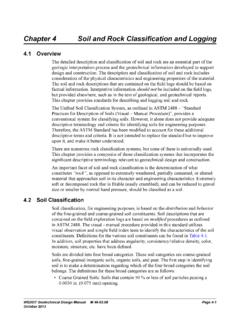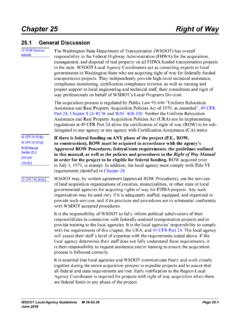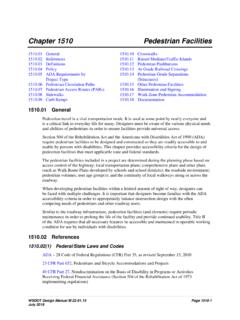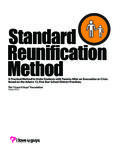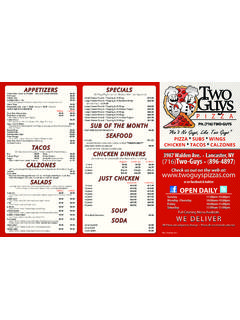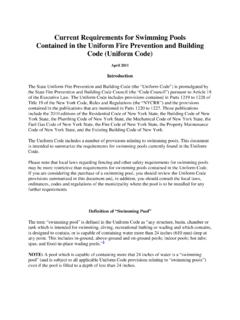Transcription of Chapter 3 Pavement Patching and Repair
1 Chapter 3 Pavement Patching and RepairGeneralThe roadway is the paved or otherwise improved portion of a public highway ordinarily used for vehicular travel. The roadway surface is normally classified as rigid (consisting of Portland Cement Concrete) or flexible (consisting of asphaltic materials).A smooth surface with good skid resistance, free of alligator cracks, pumping, pushing, wheel rutting, raveling, frost heaving, and pot holing, is desirable for safe travel by the people we of the state s roadways must include a program to preserve these characteristics. Ideally, the maintenance of Pavement should be accomplished with minimum expense and with the least possible traffic disruption.
2 Maintenance of pavements is a necessary investment made to protect the Pavement from costly renovation or maintenance is much more cost effective than performing major repairs. Area maintenance staff are required to inspect each section of highway at least once a year to detect and schedule deficiency repairs prior to their becoming a major biennial appropriation corresponding with a specific, (LOS) Level of Service for roadway maintenance and operations activities is provided by the Washington State Legislature. The maintenance area s roadway surface program should be managed to meet these LOS commitments. In doing so, it is essential that each Area work with its Program Management, Design and Construction offices to ensure that the work being planned is coordinated with the work that these offices are planning and/or is advised that written recommendations for Pavement repairs be submitted to the Regional Maintenance Engineer.
3 The Regional Maintenance Engineer then shares the region wide roadway surface maintenance program with the Regional Construction Engineer. This allows better coordination between the maintenance and construction special attention to the drainage of roadway sections when planning maintenance activities. Poor drainage can lead to premature aging of the roadway surface and zone safety and traffic control are extremely important. Maintenance employees are required to know and closely follow the Chapter in this manual on traffic control and Maintenance Manual M Page 3-1 April 2017 Maintenance of Flexible PavementsFlexible pavements generally are referred to as asphaltic concrete Pavement (ACP) or bituminous surface treatment (BST).
4 Flexible pavements develop strength from the tight interlocking of crushed rocks with an asphalt material binding them together. This mixture deflects when loaded by traffic and exerts pressure on the subgrade. Consequently, both the Pavement and the subgrade must be in good condition to avoid maintenance problems. Load and Speed RestrictionsIf the subgrade temporarily lacks strength to carry heavy loads due to excess moisture and/or thawing, any class of vehicles can be restricted by weight and/or speed. Maintenance staff must monitor the roadway condition during threatening weather conditions. Take action according to Directive D 54-43 (MR), Emergency Restrictions for Roads, before the subgrade becomes saturated and soft.
5 This will avoid unnecessary stress which can lead to permanent damage. Restrictions should be no more severe or of longer duration than necessary to protect the roadway. Consider the economic effect to the users. The damage caused by failure to place restrictions on soft roadways can have a severe effect on a maintenance budget and their ability to meet LOS DeficienciesDamage and deterioration of pavements will become apparent in a variety of ways. A number of factors can contribute to the appearance of Pavement deficiencies. For example, an overlay with excess asphalt or poorly graded or inadequately fractured paving material may not have adequate particle interlock; thus pushing, rutting, and humps may develop.
6 Poor subgrade drainage, heavy tonnage, and accelerating or decelerating traffic are all potential sources of surface irregularities. Pavement deficiencies are explained in more detail as follows:RuttingRutting is a surface depression within the wheel path and is a result of permanent deformation of the Pavement or subgrade. This condition is normally caused by heavy loads on roads lacking sufficient strength to support the loading. In some cases, rutting can also be caused by studded tire use. Wheel ruts, if not repaired, can trap water and cause Patching and Repair Chapter 3 Page 3-2 WSDOT Maintenance Manual M April 2017 Alligator CrackingThe condition known as alligator cracking is attained when discontinuous longitudinal cracks begin to interconnect to form a series of small polygons that resemble an alligator s skin.
7 This distress is usually caused by poor drainage, poor mix design, or subgrade the surface should be treated with a seal coat or overlaid with suitable material before water has an opportunity to penetrate the surface and lead to alligator cracking. If it is neglected and alligator cracks appear, heavy traffic can push the surfacing rock into the wet soil beneath it. This forces mud up through the asphalt surface (pumping) causing permanent damage that can not be repaired by a seal or overlay. Spots where severe pumping has occurred will often need to be dug out, and the base rock, surfacing rock, and asphalt CrackingA longitudinal crack follows a course approximately parallel to the centerline.
8 These are typically resultant of natural causes or traffic CrackingTransverse cracks run roughly perpendicular to the roadway centerline. They may be due to surface shrinkage caused by low temperatures, hardening of the asphalt, or cracks in underlying Pavement layers such as PCC slabs. They may extend partially or fully across the are voids in the roadway surface where pieces of the Pavement have become dislodged. Areas in which many potholes occur become suspect for fundamental problems such as inadequate drainage, Pavement strength, or base/subgrade problems. Single or infrequent potholes may be the only Pavement distress to occur in an area, and beyond the treatment of the individual pothole no other Pavement Repair work may be location of potholes which receive a temporary fix should be documented so they are addressed as part of the Area s annual permanent fix program.
9 The number of potholes that appear in the wet or winter seasons is often an indicator of the effectiveness of the permanent fix 3 Pavement Patching and RepairWSDOT Maintenance Manual M Page 3-3 April 2017 Raveling and PittingRaveling and pitting distresses are characterized by the loss or dislodgment of surface aggregate particles. Oxidized asphalt binder is often the cause of raveling and pitting. It could also be caused by poor compaction, letting the mix get cold when paving, dirty aggregate, not enough asphalt in the mix, overheating the mix during manufacture, or maintenance repairs are made to raveled or pitted surfaces is made as soon as conditions permit and/or materials are available.
10 The most important consideration in scheduling Repair of raveled or pitted areas is to perform the repairs before a more serious condition develops, and prior to the onset of inclement weather. Open grade pavements that allow water to drain through and out the side don t need to be sealed if they are properly constructed. But, Pavement that is raveling must be sealed. Unsealed pavements will continue to ravel and will also age and harden at a much faster rate than normal. This condition may also encourage the loss or stripping of the asphalt within the Pavement . Timely sealing can add significantly to the life of the Pavement . Open grade pavements should be fog sealed on a schedule recommended by the Region Materials Engineer.






